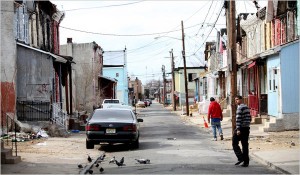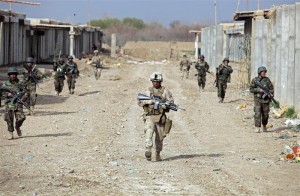budget
-
The War in Afghanistan Comes Home to Camden
Published: April 7th, 2011
Author: Will Keola ThomasWill Keola Thomas – Afghanistan Study Group
The United States is just days away from the first shutdown of its federal government in more than 15 years. Democrats and Republicans in Congress remain deadlocked over proposed spending cuts after months of political posturing and stopgap measures that have temporarily allowed the ship of state to steam ahead without an agreed upon budget. But the clock runs out this Friday at midnight and the prospects of a compromise being reached by that time look grim. Some economists are warning that a shutdown could jeopardize the country’s fragile economic recovery and increase the odds of a “double-dip” recession.
(Message to countries the United States lectures about good governance: Please ignore this blatant display of dysfunction. Do as we say, not as we do.)
Over the past two weeks intensive negotiations between the House Republican leadership and Senate Democrats have centered around a proposed $33 billion reduction in federal spending. Those talks broke down Tuesday when House Speaker John Boehner (R-OH) declared the figure was “not enough” and demanded $40 billion in budget cuts. In February, House Republicans had gone even further by passing a bill with $60 billion in proposed spending reductions.
What all these budget proposals have in common is a focus on painful cutbacks in funding for environmental protection, health care, and education that will touch the lives of all Americans. What the proposals don’t touch is funding for a war in Afghanistan that a majority of Americans believe isn’t worth fighting and whose $119 billion price tag this year dwarfs the proposed savings put forward by both political parties.
It is a glaring omission. As William Hartung of the Center for International Policy notes:
“The tax dollars being spent on Afghanistan are enough to offset the $100 billion per year that House Republicans are seeking to cut from next year’s budget, or enough to fill the projected budget gaps of the 44 states that expect to run deficits in 2012. In other words, if the Afghan war ended and the funds allocated for it were returned to the states, no state in America would run a deficit next year.”
The fiscal impact of the war in Afghanistan has been devastating for states facing one of the most difficult budget years on record. New Jersey, for example, is facing an $11 billion deficit and will, should the worst come to pass on Friday, have no federal government to turn to for help. Meanwhile, New Jersey residents will shell out $4.9 billion in taxes in 2011 to continue the war in Afghanistan.
Gov. Christopher J. Christie has proposed drastic cuts to the state budget to make up the shortfall, including “…the layoffs of 1,300 state workers, closings of state psychiatric institutions, an $820 million cut in aid to public schools, and nearly a half-billion dollars less in aid to towns and cities.”
Among the cities that will be left to fend for themselves under these cuts is Camden, New Jersey. In 2010, Camden was ranked as the second most dangerous city in America with a violent crime rate five times the national average. Yet a $26 million budget gap forced the mayor to lay off half of the city’s police force in December. The result: crime has increased 20% compared to the same period last year. As this excellent report from PBS’ Need to Know shows, the economic crisis has left Camden unable to meet the basic needs of its citizens and with nowhere to turn for assistance. One father whose oldest son was lost to the city’s violence tells his interviewer that life in Camden is “…a never-ending battle…it’s like a warzone.”
Watch the full episode. See more Need To Know.
The distorting effect of the war in Afghanistan comes into focus when one compares the “warzone” that is Camden with the never-ending battle waged by U.S. forces for the town of Marjah in Helmand Province. Though they are both beset by violence and are close in terms of population (Camden = 80,000; Marjah = 50-60,000) that is where their similarities end.
- While Camden’s police department struggles to protect its citizens with 204 officers, Marjah’s security is maintained by the presence of 2,000 Marines.
- At the same time that Camden was forced to lay off half of its police force because of a $14 million hole in the police department’s budget, Camden’s taxpayers were pitching in for their part of the $2 billion that it will cost to garrison Marjah with U.S. troops this year.
-Camden struggles with one of the highest unemployment rates in the nation and 53% of its population lives in poverty. Meanwhile the U.S. is hiring hundreds of men in Marjah to serve in local militias that many worry will prey upon the very people they are meant to protect at a cost of $500,000 every ten days in salary payments and development projects.
And while Camden’s streets are unsafe because of the absence of police officers, Marjah’s residents find themselves living in a warzone because of the presence of US troops. Which begs the question, why is the United States spending billions of dollars on a counterproductive strategy that is increasing instability in Afghanistan when those funds are so desperately needed to provide security and economic opportunity at home?Rutgers University history professor Howard Gilette told Need to Know, “We have a standard of life that we consider to be American. It’s not met in Camden.” That standard won’t be met in Camden, or in any of the other cities where it is under threat, so long as basic services for American citizens are subject to the budget axe while wasteful $119 billion wars are spared.



